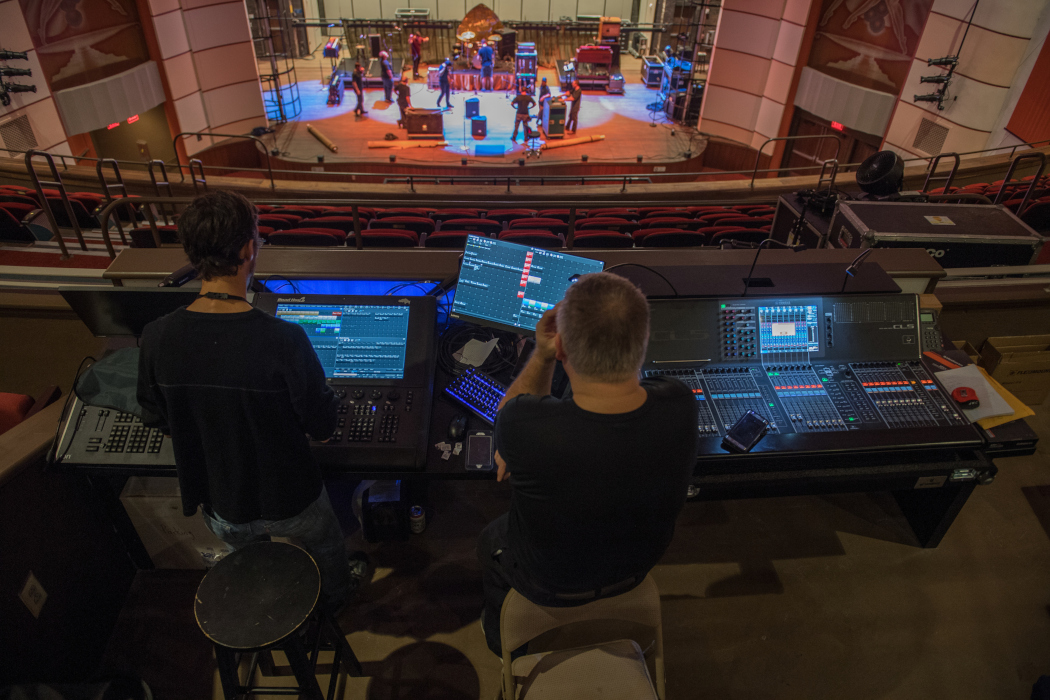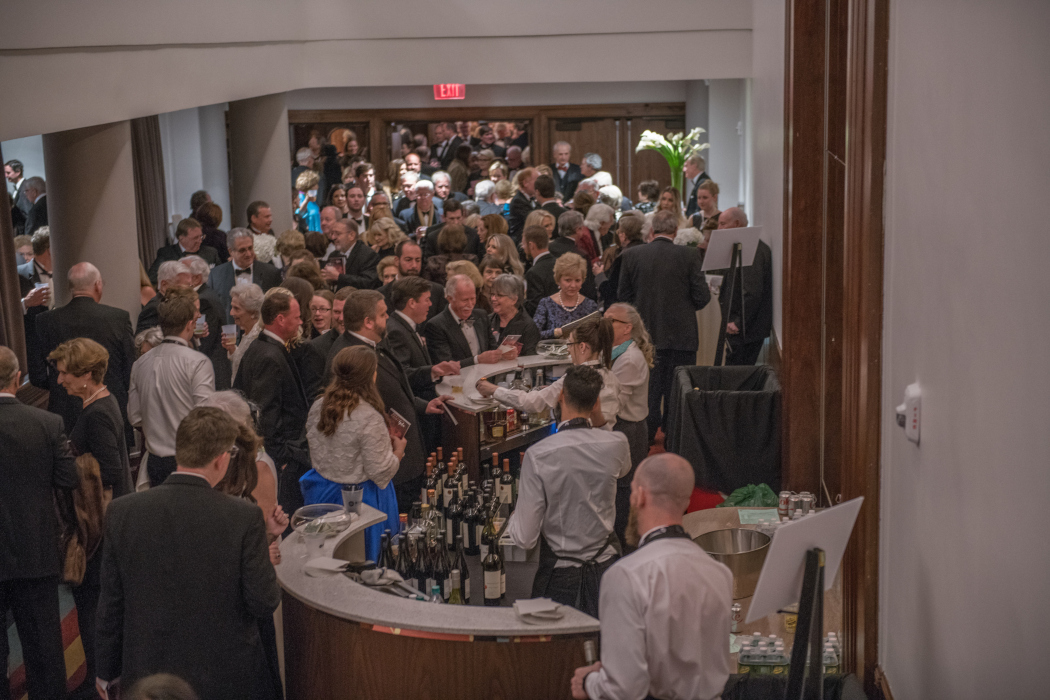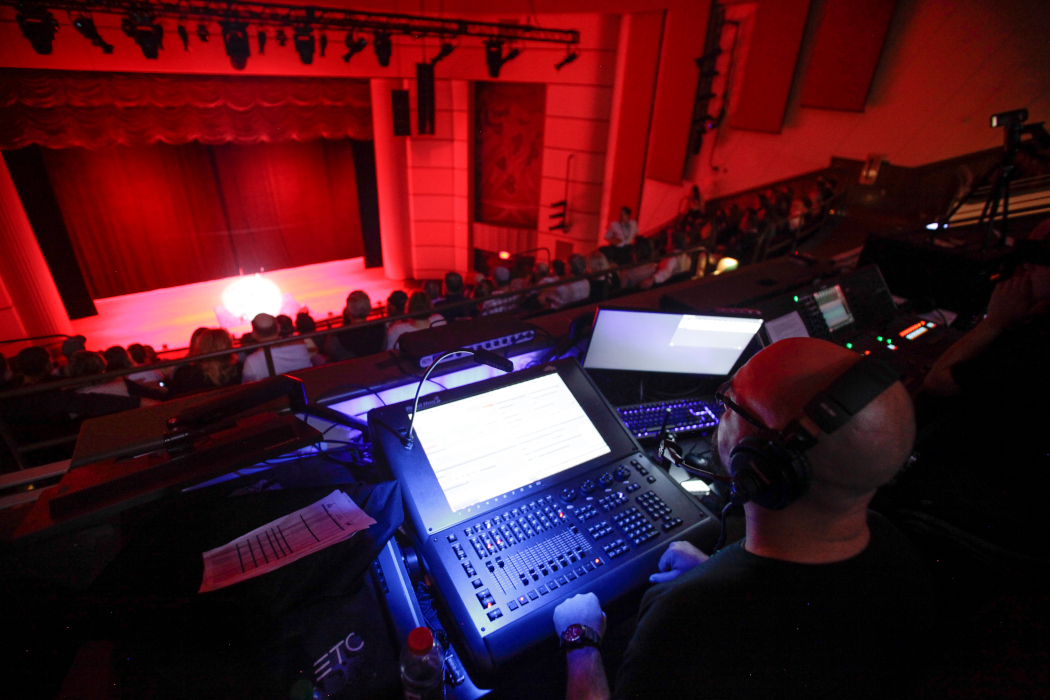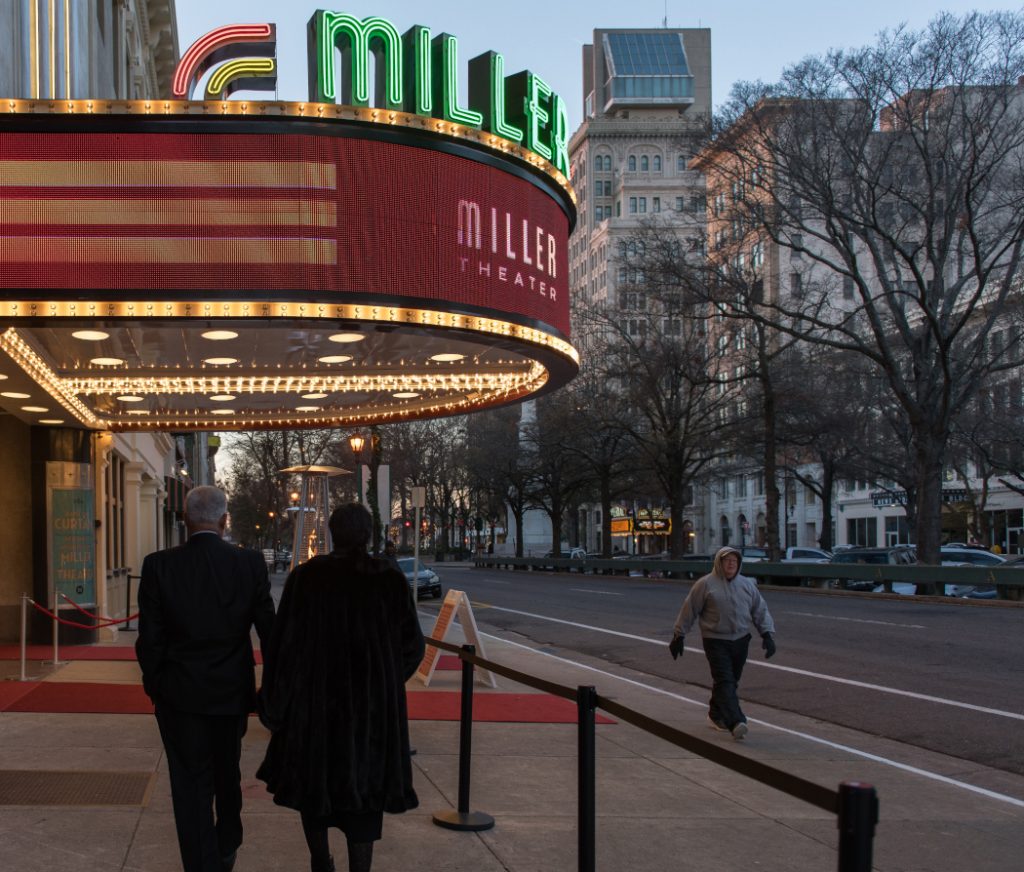Originally, the Miller Theater (Augusta GA) was built with all the streamlined delights of the US Art Moderne movement of the late 1930s. One war was done and another was just rearing its ugly head, so things were quite exciting when Frank J. Miller and his business partners decided to construct the theater, along with four other movie/live-theater spaces, in the southeastern US. Augusta Amusements felt that the way of the future was movies, plus live shows, to keep the population entertained (This was still a couple decades before television came to dominate.)
A Theater Is Born
A famed Florida architect, Roy Benjamin, was hired by Miller in 1938. In 1940, the Miller Theater—built with the latest materials, including glass brick and aluminum ornamentation—opened its doors. The interior spaces included black walnut millwork, fluted columns bearing the proscenium load and two large, slightly scandalous, hand-painted murals framing the stage. When it opened, the Miller was the second-largest theater in Georgia, behind only the Fox Theater in Atlanta GA.
Although the then-1,800-seat Miller was built as a classic American movie palace, the ability to host live shows was also central to the vision. For the opening gala week, the operators brought in 75 dancers and singers for a six-day run of “A Night at the Moulin Rouge.” All of Augusta was smitten with the city’s new status and its new theater.
However, by the 1960s, the Miller definitely had begun to show its age, and, in 1985, the theater closed. It wasn’t torn down, however. Then, in 2005, a local Augusta philanthropist, Peter Knox IV, bought the theater with an eye to saving it for the city of Augusta. Knox replaced the failing roof and removed the old carpeting and seats. He then offered it up for sale, but, unfortunately, received little interest from potential buyers. The common wisdom was that it was a money pit; thus, no one stepped up to help save it.
In 2008, Knox offered it as a gift to the Augusta Symphony, which had never had a permanent home. It was a good, professional symphony accustomed to confronting the usual problems of attempting to maintain its place in the modern world. The Augusta Symphony had some doubts about whether it wanted to take on the problems presented by the rehabilitation that would be necessary. On the other hand, though, having its own home was the next step up in professionalism. Thus, a key question was asked: Could the organization address the challenges of a complex restoration project, while still functioning as an active performing-arts organization?
Consultants of all sorts were retained to determine whether this project could be accomplished, and then managed and adequately funded. After a great deal of study, the Symphony Board of Directors accepted the dilapidated building, as gifted, in 2011.
Taking On The Challenge
With that transaction, a long quest began to find the funding required to make the project work for both the short term and the long term. In concert with local companies, foundations and benefactors, the Augusta Symphony worked toward the capital-funding total required for rehabilitation. In the end, almost $25 million was raised, including taxpayer help in the form of $5 million obtained through a special-purpose local-option sales tax.
The project team was ready to break ground in June 2016, hiring the Christman Company to remodel and restore the building. Project leaders attempted to involve much of the local community, where possible. They managed to keep and renovate the old theater-front marquee, the inside sweeping staircases, the polished geometric metal doors and other such delights. Naturally, audiovisual equipment was included in the design plan, resulting in Kirkegaard Associates, Mankin Media Systems and SMG Management being brought onboard.

Kirkegaard Associates was retained for its acoustic-design expertise and its deep pool of diverse talent in this niche. The consultancy covers more than a dozen specializations and is now more than 40 years old; its expertise and its professionalism in anticipating the needs of a full-sized symphony orchestra were thoroughly appreciated by project decision-makers.
It was understood that, from a business perspective, the Miller couldn’t have the Augusta Symphony in it every night of the year. A variety of national acts would have to use the theater—a decision that, incidentally, would bring in revenue. SMG Management helped expand the idea of what the Miller could eventually become. Meanwhile, Mankin Media Systems’ expertise in systems integration made project leaders confident that the Miller could host a wide variety of entertainment offerings, educational presentations and community-based arts events in its newly redone space, composed of 800 seats on the main floor and 500 seats in the balcony. The venue, thus, would garner enough revenue to support itself, while, at the same time, preserving all of the audio aspects required for the Augusta Symphony’s performances.
Dream Team
Kirkegaard Associates assigned Joanne Chang, CTS, ISF-C, Senior Consultant Associate, to guide the Miller Theater upgrade. She was the perfect person for the job, given her MFA in technical design and production from the Yale School of Drama. Her background also encompasses extensive experience in professional touring and production, along with theater planning and AV systems design for performing-arts venues, educational institutions and other spaces in both the US and Asia. The prescription created by acousticians Larry Kirkegaard, Joseph Myers and Shimby McCreery to make the Miller sound fabulous for a range of live events included acoustical treatments for the room and an acoustical shell onstage. The goal of the renovation’s acoustic aspects, Chang related, was to create a room in which the Augusta Symphony could play without electronic amplification, and to have a room and equipment that could support amplified concerts. She was excited to take on the challenge.
Open Communication
Chang was on the project fairly early, enabling open and frequent communication with numerous project participants involved in various aspects. In the early design phase, Kirkegaard proposed that the Miller expand to using Dante digital audio networking, as more artists shift to that technology.
According to Chang, “Because of the historic nature of the building, I worked very closely with the architect and acoustician to get the plan in place for equipment that we were going to use. Acoustical treatments and motorized acoustical banners are strategically placed to allow the room to support heavily amplified events, transforming [the space] from supportingacoustical symphony concerts.”
She continued, “Having more projects bring in the AV consultant early on, like we were on this project, means coordination and integration of various aspects of the project can be better worked out as the design progresses. A much better result can be accomplished without major afterthought construction changes, which could be costly.”
After much discussion about the Miller’s future, decision-makers chose a package that Chang presented to them that would cost more, but that would better support the kind of use the system would be getting from the major performers that’d be taking the stage. The main speaker system is composed of L-Acoustics KARAi enclosures, complemented by nearly a dozen 5XT ultra-compact coaxial enclosures, three X8 and three X12 point-source enclosures, six SB18i high-power compact subwoofers and 10 LA4X amplified controllers.
“The balcony overhang is deep and low, the upper balcony tucks in under the roof, and the ceiling there is not only low but also steps down,” Chang described. “It was a challenge for the main loudspeaker arrays to properly cover the areas. We included in-fill loudspeakers to supplement the main loudspeaker arrays so that patrons in those areas were not left out for amplified events.”
For optimal sound mixing, it is ideal for the front-of-house mix position to be set on the main floor on centerline of the room—in front of the balcony, rather than under it. “Since those are prime audience seats, that was not a popular idea,” Chang noted. Thus, the permanent front-of-house mix position is located in the middle of the balcony. However, for productions that require different positioning, an alternative solution was reached.
There is a temporary mix position on the main floor, where a set of seats can be removed to accommodate audio equipment and connection points provided in the floor boxes, allowing users to plug and play the systems, as required, when the permanent mix position is not suitable.
“Digital audio networking technology, paired with a Yamaha CL5 mixing system and Rio1608-D digital stage box, was selected for the project because of the flexibility, expandability and minimum cabling advantages it offers,” Chang affirmed.
The system currently deployed should easily be able to handle most productions’ requirements, including productions that require greater finesse. And that, as noted, helps to keep the Miller alive to the extent that it can be self-supporting and generate revenue.

Let’s turn to Mankin Media Systems, the Franklin TN-based integrator for the Miller project. The firm’s stated purpose is “to help you engage your audience,” and Mankin backs up that worthy goal with a wall full of industry awards for its work, including a 2017 Solomon Award for “Design and Installation of Audio System or Sound Reinforcement.” Dan Shivener, PMP, CTS-I, was responsible for project management, whereas the actual installation was handled by Shane Weber, CTS-D.
According to Shivener, this project was an intriguing one that he enjoyed a great deal; he mentioned the solution to have moveable seats isn’t typical, but it worked well in this case. “Elasticity was a big point for this venue,” he affirmed. “A traveling show can bring in their gear and plug in, as required, even if they need extensive analog tie-in infrastructure.”
The installation includes a Cisco SG300-20 20-port gigabit managed switch for Danteenabled networked audio. “At its core,” Shivener began, “the Dante system allows us to use the new, fully digital system options, as well as the old-school technologies, pretty seamlessly. The guy who rolls in with old-school copper-snake technologies that he has been dealing with for the last 45 years and [someone using] new, fully digital, plug-and-play connections for microphones and other gear can [both] use this system, and they will be delighted. [They’ll get] exactly the sound they want out of it.”
Robust Technical Complement
For a project that took some time to get going because proper funding had to be assured, decision-makers did not skimp on the audiovisual budget. Apart from the main sound system and mixing components, there is an extensive Clear-Com production-intercom system that includes an MS-704 main station, an RM-704 remote station, a pair of HB-704 headset stations, eight RS-701 analog beltpacks, and a number of headsets and handsets.
Because assistive listening is critical in any place of public accommodation, the Miller invested in technology from Williams Sound. The system is based on a PPA T45 Personal PA FM base station transmitter and an ANT 024 dipole wall-mount antenna. There are 41 PPA R37 PPA Select FM receivers coupled with EAR 014 dual mini earbuds.
Microphones include DPA’s 4015C. Video monitors include a Samsung 690 Series 48-inch full-HD LED and a Samsung 690 Series 32-inch full-HD Smart Hospitality LED, both of which utilize LTM1U Fusion Series tilting landscape wall mounts from Chief. Datavideo was also represented with its TLM-170GR and TLM-702HD LCD monitors.
Racks were by Middle Atlantic. Cabling was extensive and varied, including 36-inch custom crosswired loudspeaker patch cable from Whirlwind.

Unique Challenges
Every project has its unique challenges, and this one was no different. “One of the major challenges on this project was the fact that there were a number of change orders,” Shivener revealed. He also alluded to the delicacy of the historical artwork and fittings, all of which had to be kept intact, even as the AV had to be completely redone and upgraded. Another challenge involved long distances on the conduiting. Nevertheless, the team overcame all challenges to succeed.
SMG and the Augusta Symphony appointed Marty Elliott as General Manager of the Miller Theater in mid-2017. An impressive leader who boasts a 25-plus-year track record in venue and event management, she most recently led the Fifth Third Bank Stadium and the Sports and Entertainment Park at Kennesaw State University. Although Elliott was later to arrive on the scene, not all the decision-making was yet complete. That allowed her to have input and recommend changes before the metaphorical die was cast.
“When I heard that the Augusta Symphony was behind this project, I knew that the quality of sound would be the number-one priority,” she declared. “The size of the theater—1,300 patrons—meant that people would feel a special connection to the space and what was happening inside it.” By way of example, she mentioned that, to get things where they are today, more than 70 people volunteered more than 2,000 hours of their time. That is belief in, and dedication to, the vision!

“Since the beginning of our year, when we had our gala and grand opening, we’ve now had over 48 shows in the Miller, featuring a number of A-list artists,” Elliott enthused. The Miller’s in-house Sound Engineer and Production Manager, Rob Boggs, oversees the workings for Augusta Symphony, and he interfaces with personnel from the national acts that come through.
“In terms of the kinds of shows we put on, we have the job of creating a different room every night,” Elliott described. “Boz Skaggs, Diana Krall and a rock show need to feel and sound different than the symphony or a comedian. It is a fairly intimate hall to share an experience within.”
Some Tweaks
The Miller decided to make some modifications to the system after the opening. Given that a range of other shows would be using the hall, too, those artists also wanted to make sure they sounded good to every seat in the house. A key modification involved adding connection points to allow other audio consoles to be brought in and connected to the house audio system in analog.

“The national acts coming through want to use their own console, instead of the house digital console, to run the show,” Boggs explained, “and they prefer to send analog signals from their console to the house system. Thus, multiple analog connection points were needed to allow the touring companies to patch their consoles into the main DSP in analog.” (He added that some L-Acoustics 112P self-powered coaxial speakers were also installed after the scope was broadened far beyond the core needs for Augusta Symphony performances.)
“This arrangement works well for the national acts that come through,” Boggs attested. “It is now analog and covers both sides and the middle with a sub center and fill center for the whole room. Kirkegaard came back and put another analog card in the BSS Soundweb London BLU-806 signal processor so that everything would work seamlessly for this larger kind of configuration. Swapping guests over to analog settings, so their show engineers and ours could play with it as needed, has worked very well.”
Even More Multipurpose
With SMG and Elliott involved in the decision-making process, some lighting components were installed to make the venue even more multipurpose. The Miller sought out Bandit Lites, working with Senior Systems Integrator Andrew Fisher from the Charlotte NC office. He specified a package that complements the stage presence of the artists who appear.
According to Elliott, the fact that everything in the project was driven by the Augusta Symphony made a drive for higher quality permeate every corner of the building—from the kind of buffers on the doors, to the type of fabric on the seats, etc. And the results bear out that focus on exceptional quality. Everyone using the theater—performer and patron alike—has been delighted, she said with pride.
Elliott, like all the rest of us, is looking forward to many years of shows—and a vibrant artistic and cultural life—in Augusta.
